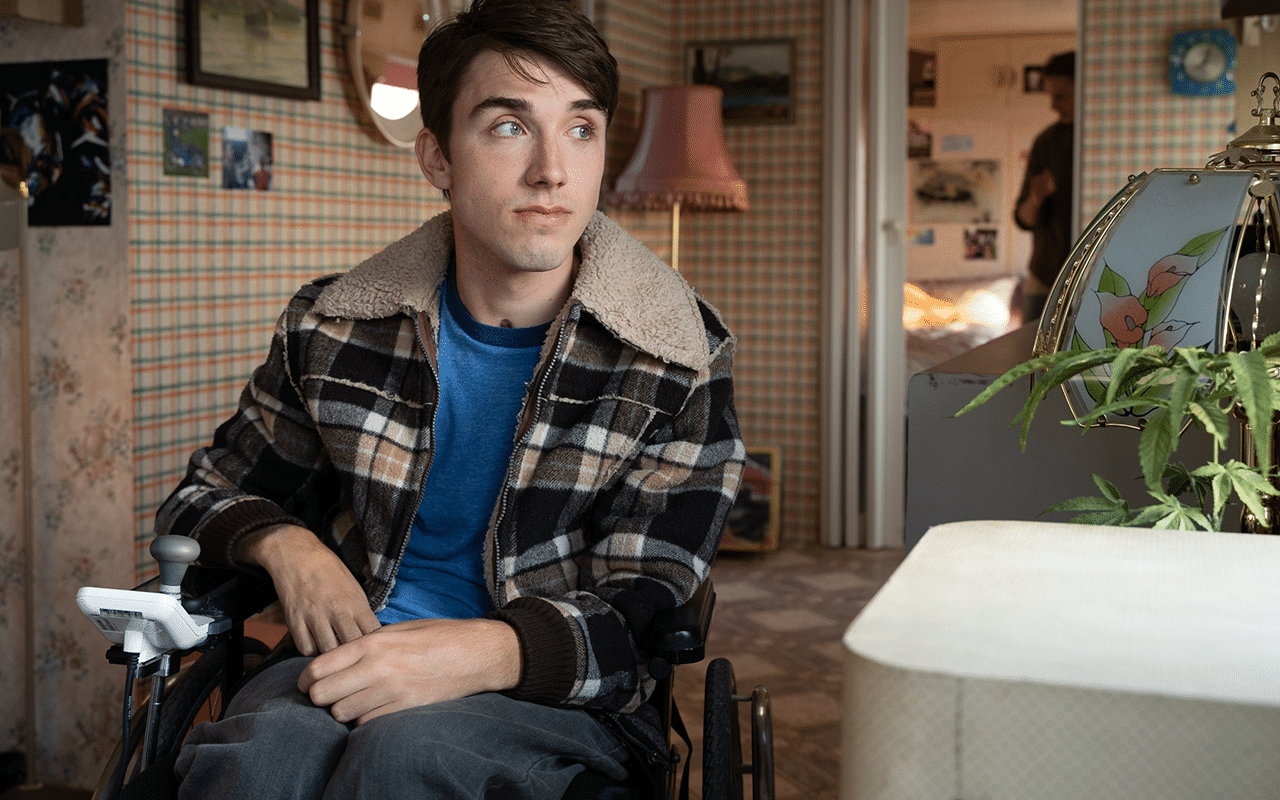
As one of the most recognisable disabled characters in recent times, Sex Education’s Isaac Goodwin is a rare example of disability representation done right. The character is well developed and multi-faceted, with a backstory and motivations that go beyond just being disabled. Isaac is depicted as a character with personal and sexual agency, and is portrayed by actor George Robinson, who uses a wheelchair himself.
But when horrific memes about pushing Isaac off a cliff or setting his wheelchair on fire began to surface on social media, it exposed the gross ableism people continue to display and forced the actor to speak out against the harm these jokes can perpetuate.
“I like to assume that the reason most people hate Isaac is not because of his wheelchair, but because he’s not necessarily likeable. However, the only way memes can communicate this is presented physically, through the wheelchair,” he said, in an interview with BBC.
He added, “It doesn’t make it right at all. It shows there’s still a long way to go in terms of how these issues are presented and how people talk about disability. It’s not on.”
Speaking out early 🚫
— Ginny & Tonic 🥤 (@GinnyAndT) September 17, 2021
You may not like Isaac from #SexEducation but if you 'joke' about hurting him by tipping him out of his wheelchair, that is NOT OK
These jokes can trigger intense trauma for us wheelchair users.
Plus, it's abusive and ableist.
Already seeing the memes…
Over the years, attempts by filmmakers and show producers to represent disability have often been marked by harmful stereotypes and tropes that further stigmatise disability, and paint a completely inaccurate picture of the lives of disabled persons.
When abled writers and directors create disabled characters, it often leads to flat and one-dimensional representations of a diverse minority group.
Here are some of the worst offenders in recent times.
Glee: Using a disabled character to teach empathy and resilience to abled characters
One of the most common disability tropes in entertainment is that of the ‘inspirationally disadvantaged’ character who exists to fulfill the sole purpose of teaching the main character a lesson about life, usually centered around gratitude.
In the first season of Glee, a high-school musical comedy that premiered in 2009, Rachel is upset over losing her voice and her ability to sing. She meets former football player Sean, who is paralyzed from the chest down. The character of Sean, who never appears in the show again, exists only to help Rachel gain perspective and realise there is more to life than singing.
Portraying disabled characters as unconditionally positive, resilient, and brave souls whose disability brings wisdom and empathy, is a huge disservice to disabled people in real life, and doesn’t allow them the space to be human, and express disappointment, bitterness, and fatigue, like abled people.
This trope also shoehorns disabled characters into props, serving to further the character development of the abled character they are helping, rather than as well-rounded characters in their own right.
GLEE AND ABLEISM THREAD!
— amy (@lovednicole) August 6, 2020
Bridgerton: The main character ‘overcoming’ a disability as character development
Shonda Rhimes’ Netflix show Bridgerton, an English period romance drama based on novels by Julia Quin, quickly rose to popularity after premiering on Netflix in December 2020. But even as viewers got hooked on Daphne Bridgerton and the Duke of Hastings’ stormy romance, the blatant colorism and ableism in the show didn’t go unnoticed.
Simon Basset, The Duke of Hastings, who is shown as a child with a speech impediment, and a neglectful, abusive father, grows up to ‘overcome’ his stutter and come into his own as the heir to Hastings. But viewers were quick to point out the inherent ableism in implying that Simon was somehow incomplete or less than with his stutter, and could only be happy after he had successfully slayed all the demons in his past, including his speech impediment.
Disability activists on Twitter have pointed out that, “Ableism shouldn’t be a character-building device.”
Yeah, I enjoyed it (was a fan of the books & of historical romance), but this really bothered me. Ableism shouldn’t be a character-building device. Hire more disabled writers & other cast/crew throughout the process. #Bridgerton https://t.co/7mAD4LQOeR
— Aparna R. (hiatus) (@aparna_r_writer) December 26, 2020
Seems strange that in a show that suspends believability in regards to race, Bridgerton seems to have stayed on point with the ableism.
— Imani Barbarin, MAGC | Crutches&Spice ♿️ (@Imani_Barbarin) February 13, 2021
Sightless: Abled actor playing a disabled character
For decades, depictions of disability on screen have been marked by the exclusion of disabled people both in front of and behind the camera. Movies like Forrest Gump, Rain Man, A Beautiful Mind, and The Theory of Everything centered disabled characters, but by featuring abled actors in these integral roles, they did a massive disservice to disability representation in media.
Over the last few years, the disabled community has been vocal about ‘nothing about us without us’— an important step towards tackling the pervasive ableism in media.
But well into 2021, movies and shows continue to feature abled actors playing disabled characters, an oversight not so different from casting a white actor to play a person of color. Films like Sightless, where Madelaine Petsch plays a blind woman who loses her sight in an attack, continue to deny disabled people these roles.
Other recent movies where abled actors have played disabled characters include Come As You Are, Music, and Me Before You.
Never Have I Ever: ‘The Magical Cure’
(TW: trauma, death)
In Netflix’s Never Have I Ever, Indian-American Devi Vishwakumar loses the use of her legs after an extremely traumatic incident when she witnesses her father’s death. Ignoring what could have been a wonderful opportunity to center a disabled character, the makers of the show decided to have Devi’s disability magically vanish at the sight of her crush, Paxton Hall-Yoshida.
Not only is this extremely unrealistic and displays a poor understanding of how trauma affects people, it also negates and minimises the lived experience of people with a permanent disability that cannot be magically cured in an instant.
“The Magical Cure is a highly offensive trope, because it undergirds the notion that the greatest thing that can possibly happen to a person with a disability is to become ‘normal.’ The greatest thing that can actually happen to a disabled person, though, is to be fully acknowledged as a multifaceted human being who need never feel ashamed about asking for accommodations that make life easier, or in some cases, possible,” disabled writer Sarah Neilson explains in a Ms. article.
‘The Magical Cure’ trope has also made appearances in Supernatural and Glee.
Just a few minutes into "Never Have I Ever" and the ableism is a mess. Leaving it aside for now.
— Heather Ure (@riotheatherrr) April 28, 2020
Continuing to feature ableist tropes and perpetuating damaging stereotypes about disabled people is just lazy. The first step in featuring disability in a respectful and authentic manner is to hire disabled writers, actors, and crew— and to stop casting abled actors in disabled roles.
If older shows from the 1990s and early 2000s like Ironside, Golden Girls, and Saved By The Bell could depict disability sensitively, there’s no excuse to claim ignorance and continue to make ableist content in 2021.

